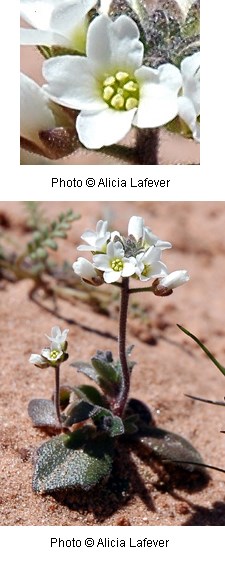
Draba cuneifolia var. cuneifolia Family: Brassicaceae (A Utah Flora – Cruciferae) – Mustard Family Annual herbs from a taproot; 3.9” to 8” (1 to 20 cm) tall Leaves: alternate, or basal and still alternate; simple; entire to toothed; has hairs; basal leaves 0.2” to 1.6” (0.5 to 4 cm) long, 0.08” to 1.08” (2 to 27 mm) wide Flowers: 4 white petals in the shape of a cross or crucifer; petals 0.12” to 0.2” (3 to 5 mm) long; 4 sepals; usually 6 stamens (with 2 outer shorter than the inner 4), sometimes 2 or 4; 1 pistil; nectar glands commonly 4 Pollinators: other genera in this family are pollinated by insects (specifically butterflies, moths, bees and flies); some self-fertile Fruits: silique - a pod with 2 compartments with a thin partition Blooms in Arches National Park: February, March, April, May Habitat in Arches National Park: desert shrub and pinyon-juniper communities Location seen: Windows, Delicate Arch Viewpoint, Fiery Furnace Other: The genus name, “Draba”, is from the Greek word “drabe” which means "sharp or acrid" referring to the burning taste of the leaves which supposedly had a medicinal value as a poultice. The species name, “cuneifolia”, means “wedge-shaped leaf”. Many plants in this family are weeds and they flower early because they are annual. Many vegetables are in this family– radish, cabbage, cauliflower. A few species of plants in this family are poisonous to livestock. |
Last updated: February 13, 2022
